Critical Ops: Sentries
Kill teams will often operate deep behind enemy lines, infiltrating hostile positions and working their way past sentries to complete their missions as covertly as possible. Here we present new rules for using sentries in your games of Warhammer 40,000: Kill Team.
Books
| Book | Kind | Edition | Version | Last update |
 Critical Operations: Sentries Mission Pack Critical Operations: Sentries Mission Pack | ||||
 Critical Operations: Sentries Mission Pack Critical Operations: Sentries Mission Pack | White Dwarf | 2 | May 2022 | |
Critical Operations Mission Pack
To randomly determine a Critical Operations: Sentries mission, one player rolls one D6 to determine a mission from the table below.
Sentries
Missions from the Critical Operations: Sentries mission pack use the Sentries mission rule, which is a prologue to the battle in which you will play through a series of sentry patrols (see below). The Attacker’s intruders can attempt to infiltrate the killzone, take up key positions and complete objectives ahead of the main assault. The Defender’s sentries must attempt to stop the intruders by patrolling the killzone and discovering them, if a mission uses the Sentries mission rule, the following changes take effect for the mission sequence:- In the Set Up Operatives step, operatives are not set up as normal. Instead, the Defender sets up two sentries with an Engage order and the Attacker sets up one intruder with a Conceal order (if they cannot be set up with these orders, they cannot be selected as sentries or intruders). These are operatives from their kill team, and they must be set up wholly within the player’s drop zone (they cannot use any rules that allow them to set up elsewhere).
- In the Scouting step, the players do not select and resolve pre-game scouting options. Instead, they resolve sentry patrols, as described below.
- Victory points cannot be scored during a sentry patrol.
- Once the alarm is raised, continue the battle as described below.
Sentry Patrol
Sentry patrols are conducted in rounds, each of which consists of a Sentry phase and an Intruder phase.Sentry Phase
The Defender selects one of their sentries and both players roll off. If their results are the same, that sentry performs a Pass action. If the Defender’s result is higher than the Attacker’s, the Defender performs a Normal Move action with that sentry. If the Attacker’s result is higher than the Defender’s, the Attacker performs a Normal Move action with that sentry. Each time a sentry performs a Normal Move action in the Sentry phase, the player moving it rolls one D6 and moves that operative up to a number of increments equal to the result of the D6. The players repeat this process until all of the Defender’s sentries have been moved or passed, or until the alarm is raised (see below), whichever comes first.Example: The Defender selects one of their sentries, and both players roll one D6. The Attacker’s result is a ‘4’ and the Defender’s result is a ‘2’ therefore the Attacker performs a Normal Move action with that sentry. The Attacker rolls one D6, and the result is a ‘3’; therefore they can move that sentry up to 3.
Once all of the Defender’s sentries have been moved or passed, and if the alarm has not been raised, the Sentry phase ends.
Intruder Phase
The Attacker activates their intruder as if it were the Firefight phase with the following additional rules:- They must have a Conceal order.
- They can only perform Dash, Normal Move, Pass or mission actions (excluding Tac Op mission actions).
Raising the Alarm
The alarm is raised if any of the following conditions are met:- The intruder is in a sentry’s Line of Sight (note that, as the intruder always has a Conceal order, it must be Visible, not Obscured and not in Cover to be in a sentry’s Line of Sight).
- The intruder is Visible to and within of a sentry.
- The intruder is within of the Defender’s drop zone (unless otherwise specified).
- The Attacker chooses to begin the assault, which automatically raises the alarm.
- Any other conditions specified by the mission.
- In the first Initiative phase, the players roll off and the winner decides who has the initiative.
- During the first Turning Point, each time an operative that was selected as an intruder or sentry is activated, the controlling player can change its order (rather than needing to have the order given to it when it was set up before the battle).
Secure the Approach
Enemy forces have been spied massing in a shrouded location, watchful sentinels guarding the approach to their only weak point. The enemies’ eyes must be blinded and that approach secured so that a full assault can be made.
Operatives can perform the following mission action:
SECURE APPROACH1AP
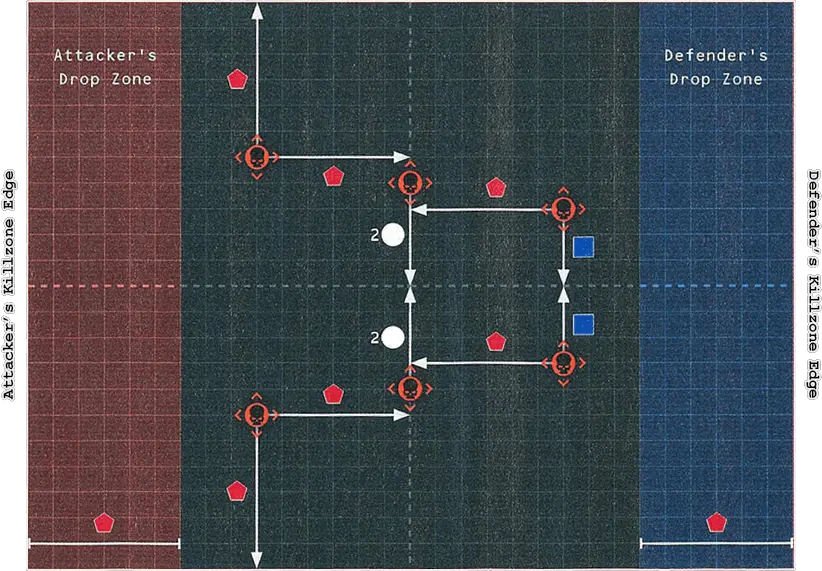
Advance Capture
Under the very noses of the enemy, one brave - or reckless - operative slips into dangerous territory alone. Vital assets must be wrested from the enemy early, before they respond in force and the main attack begins.
Alpha: At the end of the Select Drop Zone step, the Defender selects one objective marker to be their Alpha objective marker and moves it directly towards their killzone edge. The Attacker then selects one objective marker to be their Alpha objective marker (they cannot select the Defender’s Alpha objective marker) and moves it directly towards their killzone edge.
Operatives can perform the following mission actions:
SECURE ASSET1AP
CLAIM ASSET1AP
- If one or more objective markers are claimed by your kill team (see the Claim Asset action, above) you score 1VP.
- If more objective markers are claimed by your kill team than are claimed by your opponent’s kill team, you score 1 VP.
- If your opponent’s Alpha objective marker is claimed by your kill team, you score 1 VP.
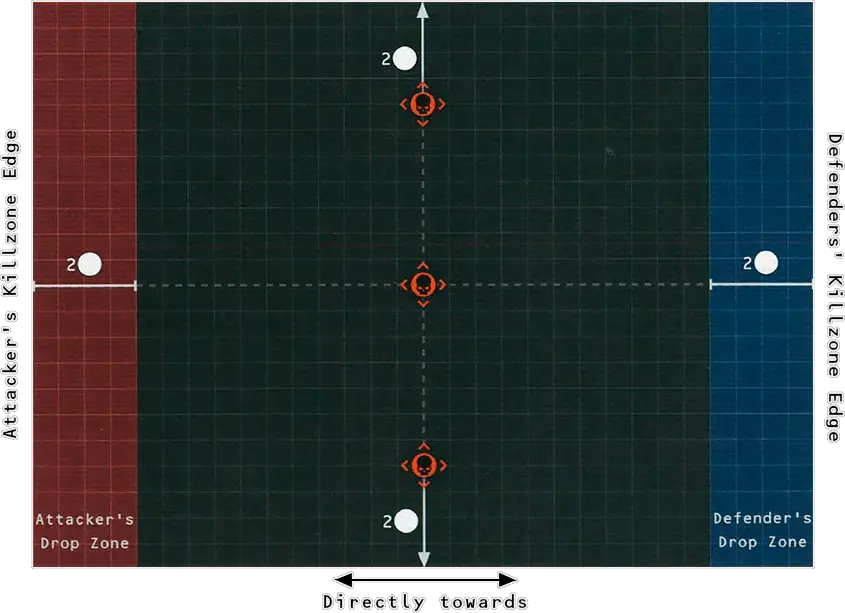
Spike Data-core
A fringe cogitator bank, xenos-node or scry terminal provides a vulnerable access point to a facility vital to the war effort. Reinforcement of the system is crucial before enemy agents sabotage it by spiking its esoteric data-core and penetrating its layered defences.
Operatives can perform the following mission actions:
ACCESS TERMINAL1AP
BREACH DEFENCE LAYER1AP
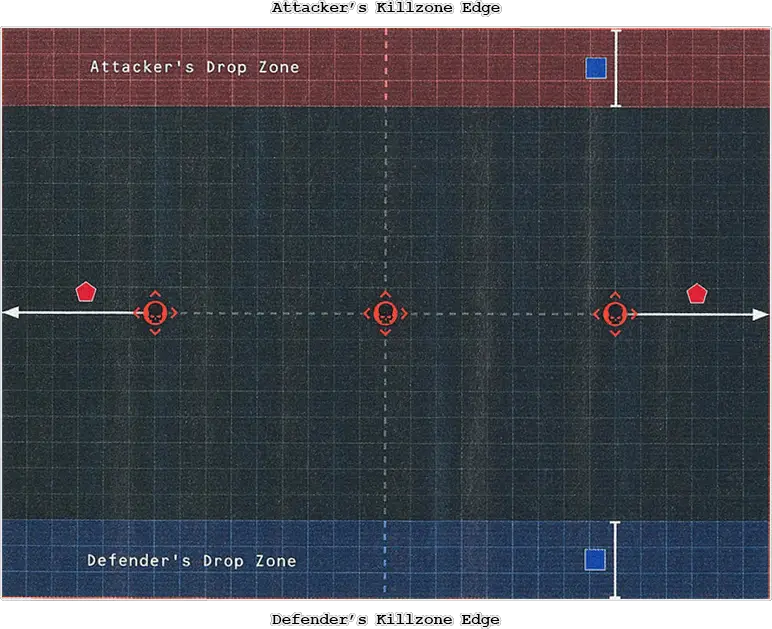
Designated Priorities
The enemy presides over a site of exponential strategic value, but the true targets must be identified as a matter of priority. They cannot be allowed to employ such vital materiel in the war to come.
Defender Designation: At the end of the first Initiative phase:
- If there are fewer than three designated objective markers, the Defender selects a number of non-designated objective markers to become designated until there are three.
- Once there are three designated objective markers, all non-designated objective markers are removed from the killzone.
Operatives can perform the following mission action:
DESIGNATE KEY ASSET1AP
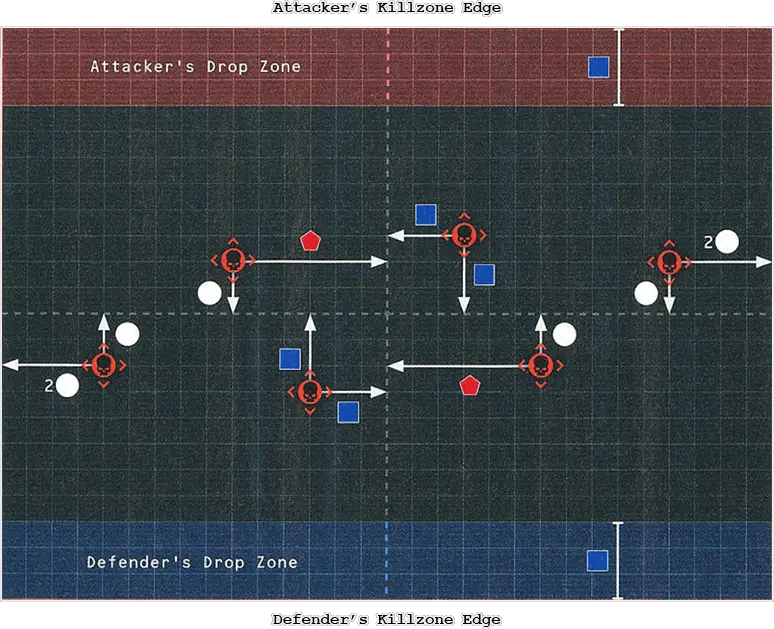
Secure Supplies
The latest night-time resupply drop has drifted off course. Several vital missions, planned months in advance, depend upon them; those supplies must be secured before the enemy's scout can loot or sabotage them.
Operatives can perform the following mission actions:
SABOTAGE SUPPLIES1AP
SECURE SUPPLIES1/2AP
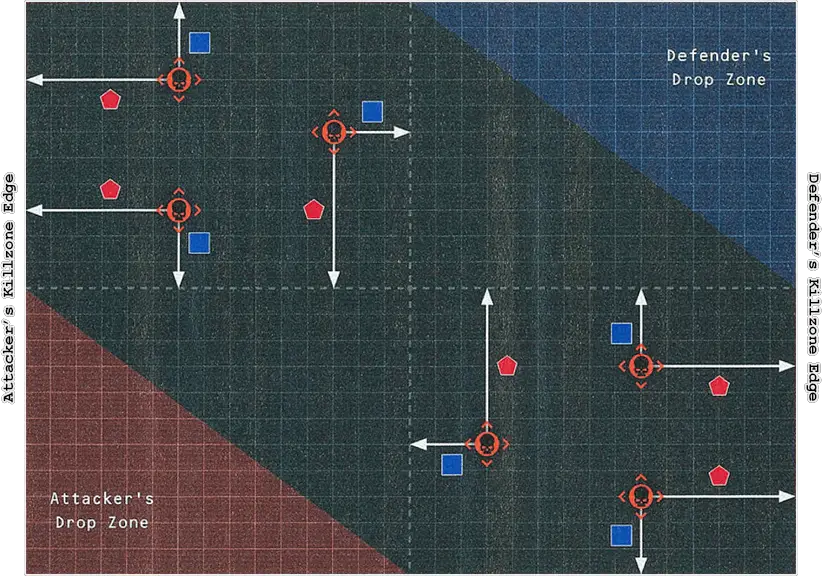
Initiate Transmission
A multi-hub communications site is patrolled by the enemy, who attempt to use it to intercept our transmissions or transmit misinformation. Our specialist must infiltrate the site to issue a priority coded warning to high command before any data is harvested.
Operatives can perform the following mission actions:
INITIATE TRANSMISSION1AP
AMPLIFY TRANSMISSION1AP
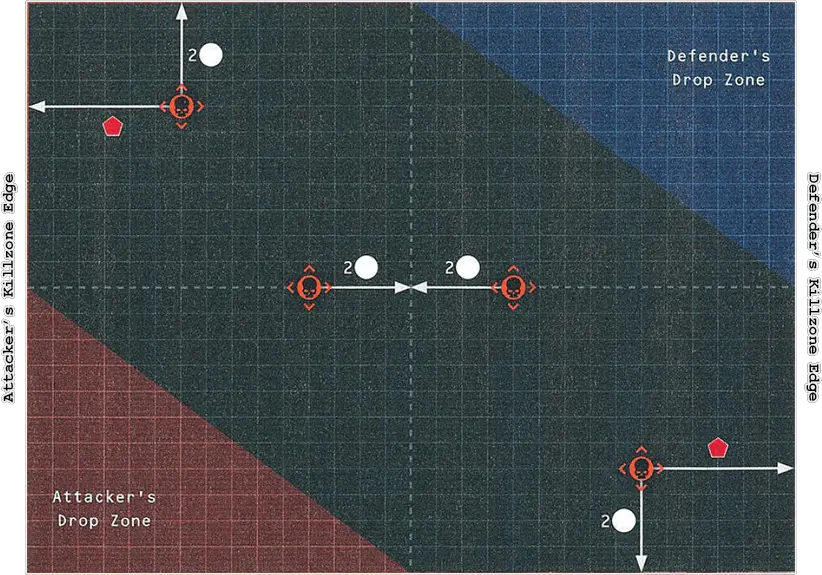
- Universal actions can be performed by all operatives. They are detailed below.
- Unique actions are actions detailed on an operative’s datacard that only they can perform, such as the Dakka Dash action found on the example datacard.
- Mission actions are specific to the mission you are playing, and will be detailed by that mission’s briefing. Missions can be found here (Open Play mission) and here (Spec Ops Narrative missions).
- Free actions can only be performed when another rule specifies. Each time an operative would perform a free action, the following rules apply.
- The operative can perform the action, so long as the requirements of the action are met.
- The player does not subtract any additional AP to perform the action.
- The operative would still count as performing the action for all rules purposes. For example, if it performed it during its activation, it would not be able to perform the action again during that activation.
For example, when a KOMMANDO DAKKA BOY performs a Dakka Dash action (see unique actions, above), it can perform a free Dash and free Shoot action without subtracting any additional AP (other than the AP spent on the Dakka Dash action). However, it is subject to those actions’ requirements, therefore it cannot perform the free Dash action if it is within Engagement Range of enemy operatives, and cannot perform the free Shoot action if it is within Engagement Range of enemy operatives or has a Conceal order. In addition, for each of the free actions it performs, it cannot perform them again during its activation.
- You can draw an imaginary, unobstructed straight line (known as a Visibility line) 1 mm wide from the head of the active operative’s miniature to any part of the miniature of the intended target (not its base).
- The intended target is more than from a point at which a Cover line crosses a terrain feature that is Obscuring (see Terrain Traits). However, if the active operative is within of a point at which a Cover line crosses a terrain feature that is Obscuring, that part of the terrain feature is not treated as Obscuring.
- The intended target is more than from the active operative.
- The intended target is within of a point at which a Cover line crosses another operative’s base (unless that other operative is not itself in the active operative’s LoS), or a terrain feature that provides Cover (see Terrain Traits).
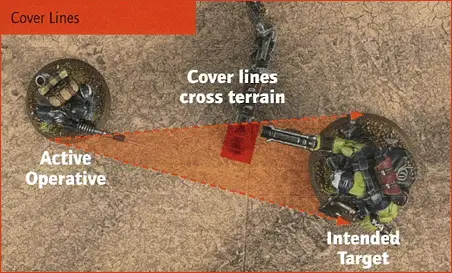

 1
1